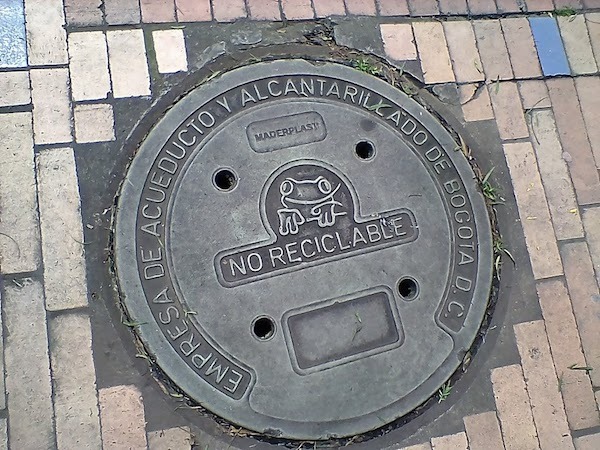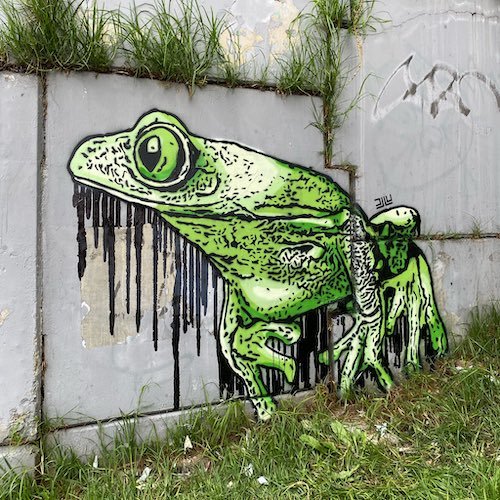La Rana Sabanera: Dendropsophus molitor
Nov. 23rd, 2021 03:57 pmWhen we visited Bogotá in 2018, Wakanomori noticed that the manhole covers had frogs on them:

I always meant to find out the story behind the frog--was it a particular frog? Why a frog? But I never did.
Then the other day, Juegasiempre (also known as DjLu), one of the graffiti artists/muralistas whose work we became acquainted with on that trip, posted this beautiful frog on Twitter: la rana sabenera, Dendropsophus molitor. (Wikipedia tells me in English it's called the green dotted tree frog.) He posted that it used to be very common in the ravines of Bogotá, but now you can hardly find it. (Original tweet here.)

I took it into my head that this MUST be the frog on the manhole covers and finally set about to find the answer.
... Well, it's not. The manhole frog is just a generalized frog, not any particular frog, but I found out that frogs have been on Bogotá's manhole covers for more than a hundred years, getting redesigns now and then. Some people thought the design was of a toad (sapo), so the workers for the Empresa de Acueducto y Alcantarillado (Bogota's water and sewer company) would sometimes be called sapos. This is unfortunate because several years of watching telenovelas has taught me that that's also what you call a snitch.
There's a Facegroup page for people who want to preserve them--it's got some photos:


As for D. molitor, it's found only in Colombia. Females are larger than males, and they can grow to be about 70 mm. They can be green or brown, and some have stripes or lines that can be black, yellow, or blue. Although Wikipedia lists it as a species of least concern, one article I found said it's threatened in parts of Colombia by the introduction of another type of frog that competes for the same habitat.
Here's a cutie from Wikipedia (link):

Live long and prosper, little guy!
Resources consulted
"Conoce a la colorida rana que habita los humedales de Bogotá," Obervatorio Ambiental de Bogotá, 14 September 2020.
"Una rana nueva llega al acueducto," El Tiempo, 5 October 1991.
"Preservemos las Tapas del Acueducto de Bogotá; Disprivatizar el Acueducto" (Facebook page)
"Dendropsophus molitor," Wikipedia.

I always meant to find out the story behind the frog--was it a particular frog? Why a frog? But I never did.
Then the other day, Juegasiempre (also known as DjLu), one of the graffiti artists/muralistas whose work we became acquainted with on that trip, posted this beautiful frog on Twitter: la rana sabenera, Dendropsophus molitor. (Wikipedia tells me in English it's called the green dotted tree frog.) He posted that it used to be very common in the ravines of Bogotá, but now you can hardly find it. (Original tweet here.)

I took it into my head that this MUST be the frog on the manhole covers and finally set about to find the answer.
... Well, it's not. The manhole frog is just a generalized frog, not any particular frog, but I found out that frogs have been on Bogotá's manhole covers for more than a hundred years, getting redesigns now and then. Some people thought the design was of a toad (sapo), so the workers for the Empresa de Acueducto y Alcantarillado (Bogota's water and sewer company) would sometimes be called sapos. This is unfortunate because several years of watching telenovelas has taught me that that's also what you call a snitch.
There's a Facegroup page for people who want to preserve them--it's got some photos:


As for D. molitor, it's found only in Colombia. Females are larger than males, and they can grow to be about 70 mm. They can be green or brown, and some have stripes or lines that can be black, yellow, or blue. Although Wikipedia lists it as a species of least concern, one article I found said it's threatened in parts of Colombia by the introduction of another type of frog that competes for the same habitat.
Here's a cutie from Wikipedia (link):

Live long and prosper, little guy!
Resources consulted
"Conoce a la colorida rana que habita los humedales de Bogotá," Obervatorio Ambiental de Bogotá, 14 September 2020.
"Una rana nueva llega al acueducto," El Tiempo, 5 October 1991.
"Preservemos las Tapas del Acueducto de Bogotá; Disprivatizar el Acueducto" (Facebook page)
"Dendropsophus molitor," Wikipedia.
no subject
Date: 2021-11-23 11:49 pm (UTC)In the Chilean Spanish I learned as a kid, ranas are toads and sapos are frogs. I guess my parents had it backwards?! Or I got my meanings crossed somewhere along the way.
no subject
Date: 2021-11-24 01:37 am (UTC)no subject
Date: 2021-11-24 02:40 am (UTC)I saw a green and gold striped frog in my frog pond this morning - it was almost certainly a Motorbike Frog. [They come in a wide variety of colours, including green and gold stripes]
https://museum.wa.gov.au/explore/frogwatch/frogs/motorbike-frog
no subject
Date: 2021-11-24 03:16 am (UTC)And thank YOU for sharing
Date: 2021-11-26 10:17 am (UTC)Not knowing you were from Australia--and generally not paying attention to the link or title info--when I read the first line of the article ("The south-west's most commonly encountered frog), I thought, "huh, sad, but I don't think I ever saw one growing up." I grew up in the U.S. Southwest. :D
no subject
Date: 2021-11-26 03:28 pm (UTC)It's called the motorbike frog because it's call sounds like a motorbike - you can listen to the sound at the link
no subject
Date: 2021-11-26 05:18 pm (UTC)no subject
Date: 2021-11-26 06:03 pm (UTC)no subject
Date: 2021-11-26 06:52 pm (UTC)no subject
Date: 2021-11-26 06:58 pm (UTC)no subject
Date: 2021-11-26 07:10 pm (UTC)https://museum.wa.gov.au/explore/frogwatch/frogs/moaning-frog
no subject
Date: 2021-11-26 07:11 pm (UTC)Frogs are just wonderful.
no subject
Date: 2021-11-26 07:15 pm (UTC)not in my suburb, but these two are amazing
Hooting frog
A low pitched owl-like 'hoot' repeated slowly.
https://museum.wa.gov.au/explore/frogwatch/frogs/hooting-frog
Quacking frog
Similar to the sound of a duck quacking. Often call in discrete bursts, and males will mirror the number of quacks a neighbor gives.
https://museum.wa.gov.au/explore/frogwatch/frogs/quacking-frog
no subject
Date: 2021-11-26 07:31 pm (UTC)no subject
Date: 2021-11-24 06:57 am (UTC)That's so neat! Is there a reason for it, or did the city a hundred years ago just think it looked good? (If so, they were right.)
As for D. molitor, it's found only in Colombia.
It's very beautiful.
Current Music: Pete Seeger: Frog Went a-Courting
Aaaaaah, I have that song on and off in my head a couple of times a month, I have no idea why, thanks.
no subject
Date: 2021-11-24 01:09 pm (UTC)Re: Pete Seeger's Frog Went a-Courting--I picked it to listen to for this entry :-) I love the song. Have you ever heard Sam Hinton's version? That's the one I heard in my childhood--on the very album featured as the image for that Youtube video. I would take it out of the library and listen to it.
I really loved this picturebook of it, too.
no subject
Date: 2021-11-26 10:23 am (UTC)no subject
Date: 2021-11-26 01:03 pm (UTC)no subject
Date: 2021-11-26 05:23 pm (UTC)no subject
Date: 2021-11-24 10:38 am (UTC)no subject
Date: 2021-11-24 01:13 pm (UTC)no subject
Date: 2021-11-26 10:18 am (UTC)no subject
Date: 2021-11-26 01:00 pm (UTC)no subject
Date: 2021-11-26 05:24 pm (UTC)no subject
Date: 2021-11-24 01:08 pm (UTC)Do you have spring peepers out your way? I miss them.
no subject
Date: 2021-11-24 01:14 pm (UTC)no subject
Date: 2021-11-26 10:21 am (UTC)Back in the day, when I collected things, I collecting ting frog figurines because I have always had a love for frogs. Don't know where it came from; just always found them fascinating and beautiful, from their life-cycle, looks, and songs.
no subject
Date: 2021-11-26 01:57 pm (UTC)And I totally get being into frogs. They ARE fascinating and beautiful, and they do have excellent folksongs and lore behind them :-)